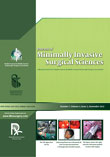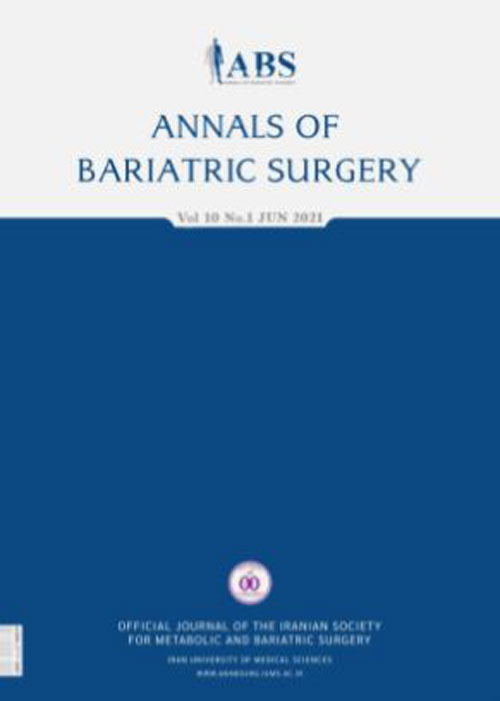فهرست مطالب

Annals of Bariatric Surgery
Volume:4 Issue: 1, Winter 2015
- تاریخ انتشار: 1394/04/02
- تعداد عناوین: 6
-
-
Page 1IntroductionHepatic choristomas, defined as completely separated ectopic liver tissue, are rare. They are most commonly found adjacent to the gallbladder. Details of their anatomy, such as blood supply and biliary drainage, remain ill-defined and are inconsistently described in the literature..Case PresentationA case of hepatic choristoma was found incidentally in a 77-year-old woman during an elective laparoscopic cholecystectomy..ConclusionsWe outlined its biliary drainage and blood supply, as well as our surgical approach, which may be a guide to surgeons who encounter hepatic choristomas in their clinical practice..Keywords: Choristoma, Cholecystectomy, Gallbladder
-
Page 2BackgroundLaparoscopic cholecystectomy (LC) is the gold standard treatment for cholelithiasis..ObjectivesOur study intended to evaluate whether timing of surgery is of any influence on the course of the laparoscopic cholecystectomy (LC) following Endoscopic Retrograde Cholangio-Pancreatography ERCP/Endoscopic sphincterotomy (ES) and to identify and assess various factors that can affect the outcome in these patients..Patients andMethodsData of 77 patients treated for choledochocystolithiasis with ERCP/ES followed by LC were reviewed. Patients were classified into four groups, group A (n = 29): LC performed within 24 hours after ERCP; group B (n = 20): LC performed after 24 hours to 7 days; group C (n = 12): LC done between 8 to 28 days; group D (n = 16): LC done after 28 days of ERCP. Primary outcome was operating time and secondary outcomes included intra- or post-operative complications, hospital stay and hospital expenses..ResultsMean operative time was shortest in group A (57.1 minutes) and longest in group B [63.4 (P = 0.131)]. Mean hospital stay was shortest in group A (2.1 days) and longest in group C (5.7 days) (P = 0.003). Hospital expenses were minimal in group A (P = 0.001). Male sex, serum bilirubin level, White blood cell (WBC) count, duration of ERCP/ES procedure, contracted gall bladder and large calculus size on Ultrasonography (USG) were significantly associated with primary outcome..ConclusionsLC can be performed within 24 hours of ERCP/ES with favorable outcome and less expenses. Timing of LC after ERCP/ES is not significantly associated with outcome of the procedure. Male sex, serum bilirubin level, WBC count, ERCP/ES procedure duration, contracted gall bladder and large size of gall bladder calculus on imaging are significantly associated with difficulty in surgery..Keywords: Choledocholithiasis, Cholelithiasis, Laparoscopic Cholecystectomy
-
Page 3BackgroundLaparoscopic surgery provides tremendous benefits to patients, including faster recovery, shorter hospital stay, and earlier return to normal activities and less immunologic impairments..ObjectivesIn this study we aimed to study the effect of different intraperitoneal instillations on leukocyte count to evaluate patients’ immunologic response..Patients andMethodsWe studied 125 patients in a double-blind, randomized clinical trial. The patients received either instillation of 250 mL of normal saline (n = 31) or 100 mg bupivacaine diluted in 250 mL of normal saline (n = 31) or 100 mg hydrocortisone diluted in 250 mL of normal saline (n = 31) or 100 mg hydrocortisone plus 100 mg bupivacaine diluted in 250 mL normal saline (n = 32) before insufflation of Carbon Dioxide into the peritoneum randomly. Leukocyte counts were recorded before and after the operation. We recorded abdominal pain using visual analogue scale (VAS), postoperative analgesics needed and recovery variables in the recovery room and 6, 12 and 24 hours after the operation..ResultsThe study was completed by 120 patients. Patients who received intraperitoneal hydrocortisone and hydrocortisone plus bupivacaine had higher white blood cell (WBC) count (P < 0.0001). The patients were similar with respect to demographic information, operational characteristics and recovery variables. The abdominal pain scores were significantly lower in patients receiving instilled intraperitoneal hydrocortisone plus bupivacaine and less analgesic was require by them (P < 0.0001)..ConclusionsWe conclude that intraperitoneal hydrocortisone instillation caused leukocytosis and is thus suggested not to be used in immune-compromised patients..Keywords: Hydrocortisone, Injections, Intraperitoneal, Leukocytosis
-
Page 4IntroductionAlthough thymoma is the most common anterior mediastinal tumor, only 5% of thymoma cases develop pure red cell aplasia (PRCA)..Case PresentationIn this article we have reported a 59-year-old man with a large anterior mediastinal mass (diameter of 10 cm) and severe anemia, that thymoma and pure red cell aplasia have been demonstrated by histopathologic and hematological examination. Despite the large mass, a complete video-assisted thoracoscopic surgery (VATS) thymectomy and combinational medical therapy were performed for him successfully. Aplasia remission occurred 6 months after thymectomy and his hemoglobin level reached to 13 g/dL..ConclusionsWe believe that a complete resection in combination with medical therapy is necessary to achieve total remission of PRCA symptoms and conclude that VATS thymectomy is an effective and technically feasible procedure for surgery without any contraindications about the size of the thymoma in these patients..Keywords: Pure Red Cell Aplasia, Thymectomy, Thoracoscopy
-
Page 5IntroductionAcute appendicitis (AA) is one of the most common differential diagnoses in a pregnant lady presented with right iliac fossa (RIF) pain. Traditional concept of early exploration has been questioned, as far as recent evidences showed much higher morbidity rates than expected. Mandatory pre-operative imaging (ultrasound or Computer Tomography scan) has been advocated and proven able to significantly reduce its related avoidable morbidity..Case PresentationThree cases are presented: Case 1 was a 41-year-old lady who had acute appendicitis which was successfully managed conservatively. Case 2 was a 29-year-old lady at 25 weeks of gestation, presented with 2 weeks history of RIF pain. Open appendectomy was offered for her, as far as obstetric review and ultrasound were inconclusive. Even though, she had a negative appendectomy, and her postoperative period was complicated by recurrent premature uterine contractions. The third case was an unfortunate lady at 30 weeks of gestation. Laparotomy was done for her, as her RIF pain persisted, which was diagnosed by significant fluids at both iliac fossae with other unremarkable obstetric review. Her postoperative period was complicated by paralytic ileus and intra-uterine death..ConclusionsOur review demonstrated that a pregnant lady suspected of AA poses a great clinical challenge to surgeons, as far as scoring systems are almost unreliable. Positive imaging prior to surgery is warranted, in order to avoid a nontherapeutic surgery which is always associated with high morbidity rates..Keywords: Appendicitis, Pregnancy, Complications
-
Page 6


